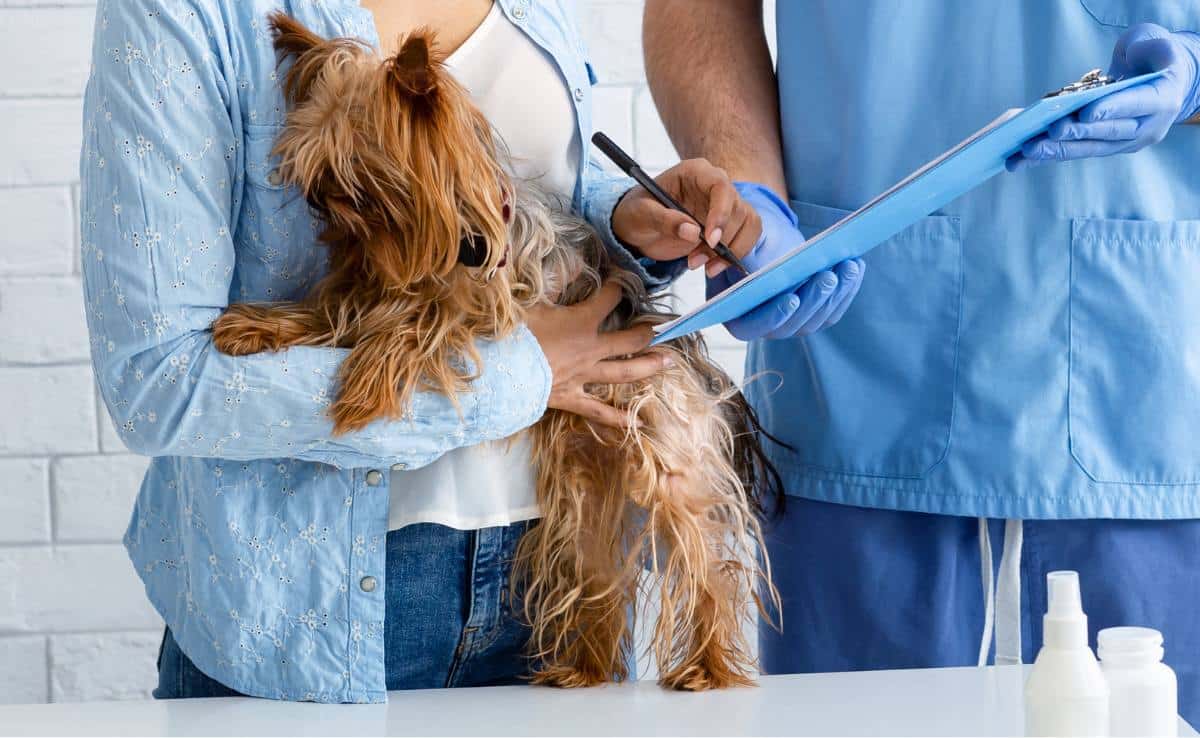Does Pet Insurance Cover MRI Scans?
When you purchase through links on our site, we may earn a commission. Here’s how it works.

Sometimes, our dogs need veterinary testing to help diagnose and treat a condition. Unfortunately, this can be unsettling and expensive if you’re unprepared for a hefty bill. You’re not only anxious about your dog’s health but also about how you’ll pay for the vet expenses. Find out when pet insurance covers magnetic resonance imaging (MRI) and when it’s excluded.
Table of Contents
What Is An MRI?
An MRI (magnetic resonance imaging) provides images of the body’s tissues and helps veterinarians evaluate your dog’s nervous and musculoskeletal systems. They also allow imaging from all three planes of the body (top to bottom, left to right, and front to back) without moving the patient.
The patient must be still during an MRI, so dogs are placed under general anesthesia. Before administering anesthesia, blood samples may be taken to evaluate red and white blood cell counts, electrolyte levels, and liver and kidney function. This can help assess any concerns with placing your dog under anesthesia. After your furry friend is safely under anesthesia, the MRI takes between 45 minutes and two hours.
What’s The Difference Between An MRI, CT Scan, X-Ray & Ultrasound?
MRI scans, CT (computerized tomography) scans, X-rays, and ultrasounds are all non-invasive diagnostic tests. Veterinarians and other medical professionals request different diagnostics to obtain images of the body inside and out and determine if surgery or another treatment is needed.
- A type of electromagnetic radiation called an X-ray creates black-and-white images on a monitor by penetrating bodily tissue. To shield themselves from excessive exposure, patients wear lead vests. X-rays (or radiographs) are often requested to examine teeth, broken bones, and foreign objects. Dog X-ray costs range from $75-$500.
- Sound waves are used in ultrasounds to image internal body structures. As the waves travel through the body, they catch shadows and reflections that can be seen instantaneously on a computer screen. An ultrasound uses no radiation. Pregnant patients are frequently examined with ultrasounds.
- With a CT scan, quick X-ray images are taken to provide a complete, detailed picture of the scanned area. Medical professionals usually order a CT scan prior to an MRI. CT scans can reveal early arthritis and tumors and the blood vessels surrounding it. Medical staff often uses these images to determine if cancer has spread to other parts of the body.
- Strong magnetic fields and radio frequency pulses are used in MRIs to create detailed images of soft tissues, including the intervertebral discs, brain, muscles, ligaments, and tendons. A CT scan or other diagnostic test may miss abnormalities that an MRI can find.
Depending on the findings of the imagery, the veterinarian can determine a treatment plan that includes any necessary medications, surgery removal, therapy, and future prevention.
How Much Does An MRI Scan For Dogs Cost?
According to Fetch Pet Insurance claims data, the cost of an MRI for a dog can average $2,000 or more. You may also need to see a specialist to obtain an MRI, which could result in additional exam fees. That’s a hefty bill to pay, which is why having pet insurance can be so monumental to your finances. The average monthly premium for an accident-and-illness pet insurance policy is around $55.
When Will Pet Insurance Cover MRI Scans?
Pet health insurance plans cover MRI scans for procedures of eligible accidents and illnesses. Eligible accidents and illnesses include conditions not diagnosed or presented before the pet insurance policy’s effective date and applicable waiting periods.

When Are MRIs Excluded From Pet Insurance?
Pet insurance coverage excludes MRI scans if the need is associated with a pre-existing condition or an excluded accident or illness.
For example, let’s say your puppy was diagnosed with a seizure condition before you enrolled her in pet insurance. A few months after you purchased pet insurance, she needed an MRI to do further diagnostic analysis for treatments for her seizures. In this instance, the MRI would be ineligible for coverage because it’s associated with a pre-existing seizure condition.
Best Pet Insurance For MRI Scans
Fortunately, you have many options for dog insurance companies that cover MRIs associated with a new diagnosis. Our pet insurance comparison allows you to analyze the top pet insurance providers. We have comparison tables for pet insurance plan customizations, coverage and exclusions, waiting periods, age limitations, and sample price quotes to help you see how the pet insurance companies differ. All current insurance policies cover MRIs as long as they are unrelated to a pre-existing or excluded condition. Be sure to read the fine print before you sign up for a new insurance policy to ensure your needs are addressed.
Methodology: How We Rank The Best Pet Insurance Companies
My team and I conduct extensive research on the most reputable pet insurance companies, analyzing customer feedback, policy changes, and industry trends. Our licensed insurance agent fact-checks everything, and we update our reviews year-round as insurers adjust premiums, coverage, exclusions, and customer service.
We rank each U.S. pet insurance provider using a 100-point scale, ensuring an unbiased breakdown of how companies perform in real-world claims.
Our Ranking Criteria
- Coverage & Exclusions (30%) – We analyze policies, exclusions, and age restrictions, rewarding companies with fewer coverage limitations.
- Pricing (15%) – We run thousands of sample quotes and factor in extra fees, discounts, and add-ons.
- Customer Service & Reputation (12%) – We review hundreds of customer experiences, assess the sign-up process, and evaluate claim support.
- Financial Strength (10%) – We examine A.M. Best & Demotech ratings to ensure companies can pay claims reliably.
- Customization Options (10%) – Providers with more deductible, reimbursement, and payout flexibility rank higher.
- Waiting Periods (5%) – Shorter illness & accident waiting periods result in a better score.
- Claim Processing (5%) – Companies offering fast reimbursements and direct vet pay score higher.
- Innovation (3%) – We recognize unique offerings and advanced technology in the industry.
Unbiased Pet Insurance Rankings: Putting Pets First
Unlike many review sites, we don’t sell rankings—every provider earns its spot based on real performance. Our in-depth comparisons help pet parents make informed decisions, while insurers use our reviews to improve their policies. We only recommend the best because that’s what our readers deserve.
Why Trust Canine Journal?
Canine Journal has been covering the topic of pet insurance for 12+ years, well before other conglomerates discovered the rising popularity of health care for our pets. Many of our authors have personal experience with pet insurance, including Kimberly Alt, who has been Canine Journal’s go-to author for pet insurance for over a decade, having written about nearly every possible facet related to pet insurance. Kimberly reads every line in all pet insurance plans to help her answer a breadth and depth of pet insurance questions immediately. And on the rare occasion she doesn’t know the answer off the top of her head, she can find it within minutes due to her extensive list of resources. Kimberly has helped countless readers answer the question, “Is pet insurance worth it for me?” because there’s no one-size-fits-all for pet insurance, and each pet is unique.



